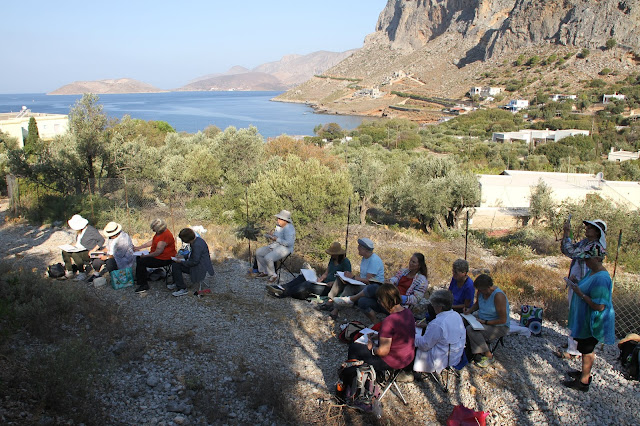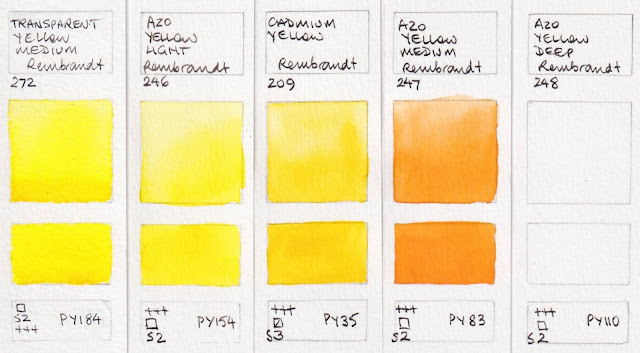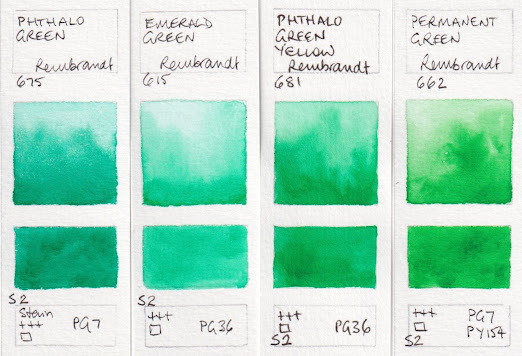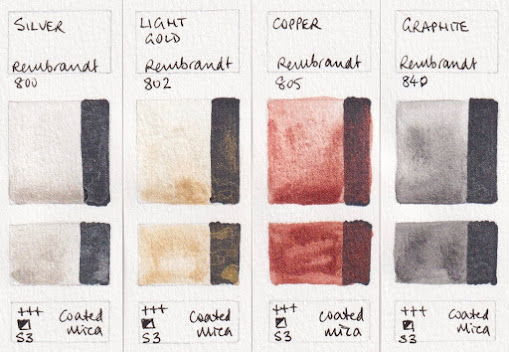I've used and travelled with many sketchbooks since I first sat outside trying to sketch a duck pond when I was 11. In recent years, I've really concentrated on working in sketchbooks that will take watercolour washes. I'll include a number of them here.
I created a template so I could easily draw the same arrangement of squares in each book, then painted the boxes in the same colours to give a comparison of the papers. I've then scanned them all on the same scanner. Most colours look pretty accurate but Cerulean Chromium looks more turquoise in all of the samples. I'll add my notes about now I felt painting them. Some papers required a faster touch than others.
While I have more information on these on my website here, I thought this may be the best way to allow easy comparison of the paper types. I have loaded them in no particular order. I haven't shown the liftability of each paper. (That's not a word, but I think it's useful ;-) so will do that another time.
The colours I've used are my suggested 12-colour urban sketching palette and are all Daniel Smith - buff titanium, hansa yellow medium, quinacridone gold, quinacridone rose, ultramarine, cerulean chromium, perylene green, goethite, burnt sienna, Indian red, raw umber and Jane's grey. You can read more about that on my website here or on my blog, set up in a palette, here.
The sketchbooks that I like best may not suit everyone best. It depends how quickly you work, how detailed, how much water you use and whether you paint on both sides. I work relatively slowly, with a lot of detail and accurate colour. I love watercolour granulation. The paper that works best for me generally has a high cotton content and I really like 200gsm for sketchbooks so you get a lot of pages in the book. For my framed works outside of a sketchbook, though, I prefer 300gsm paper. I personally always prefer a medium or cold pressed paper to rough or really smooth, as I like to use fountain pens with fine or even extra fine nibs along with the watercolour. And yet I have enjoyed using a lot of 150gsm Alpha books! So I use one type for quick work and another for more detailed watercolour painted sketches.
Stillman & Birn - Alpha.
This comes in a range of sizes and in spiral, hardcover or soft cover. It is 150gsm paper designed to take light washes. The paper is a bright white, takes fountain pen and pencil really well and has a very slight texture, described as a vellum surface.
I enjoy this as a paper to use for notes and sketches, where I'll be doing more writing than sketching, or for quick sketches, demonstrations or colour studies. I've used many of them in many sizes, especially the landscape format hard-bound 9x6" hardbound books. There is some show-through, but remarkably little. There is also a little buckling but it has never worried me. The soft-bound are lighter for travel but I personally prefer the hard covers.
This is the lightest weight paper I've used with watercolour and I think I've used more Alpha books than any other!
 |
| Stillman & Birn Alpha sketchbook sample page |
Global Handbook Watercolour sketchbook.
This paper comes in a range of sizes and interesting shapes and is fairly strongly textured paper. The cover is a light grey fabric hard-cover. It is 200gsm, which I think is a good thickness for a sketchbook. The paper is natural white and the texture is similar, though not identical, on both sides. I feel that is has slightly too much of a right and wrong side for best results but it's a nice book.
 |
| Global Handbook Watercolour Sketchbook sample page |
Hahnemühle Watercolour Book
This paper is a natural white, acid free and has a fine grained texture on both sides. I think it is great for pencil and pen with smaller areas of wash, though a little more tricky if you want to create larger smooth washes. It comes in a range of shapes and sizes including new zig-zag formats.
 |
| Hahnemühle Watercolour Book sample page |
The original Moleskine watercolour notebook had wonderful 200gsm natural white paper, with the same cold pressed texture on both sides. I loved this paper when I first started using it in 2009. It took pen and pencil well and watercolour behaved very predictably on it.
 |
| Moleskine Watercolour sketchbook (original) sample page |
Moleskine Watercolour Notebook (2nd Generation)
This is 200gsm paper in the same natural white colour as the Hahnemühle and Global. It is 25% cotton, acid free. But is has quite a different texture on each side of the paper. I understand it has improved but I haven't tried the latest version. This sample is painted on the 'right' side.
 |
| Moleskine Watercolour sketchbook (2nd generation) sample page |
Stillman & Birn - Zeta
This is a smooth surfaced 270 gsm paper in a bright white. It is gorgeous for pen and pencil but you need to use watercolour very quickly to keep in under control. Personally I always prefer to use watercolour on cold pressed rather than smooth or hot-pressed papers, but many like the smooth surface. Excellent for pen or pencil work.
 |
| Stillman & Birn Zeta sketchbook sample page |
Stillman & Birn - Beta
This is a brighter white paper like the Alpha, but in a heavier 270gsm weight. While it is cold pressed with a surface that takes pen or pencil beautifully, you have to work quickly with watercolours so it is more difficult to control. It is best for single pass watercolour techniques and no fiddling.
 |
| Stillman & Birn Beta sketchbook sample page |
Koval Sketch Book - Pro
This is 300gsm cold pressed, acid free, 100% cotton extra white Fabriano Artistico paper. Just lovely. It is very easy to control the watercolour washes and it shows the granulation of the pigments beautifully.
Hand made and really well put together, this is available in a range of sizes and shapes. They also make 50% cotton and 200gsm weight and include rough and smooth surfaces in the range.
This is a company well worth checking out. It was started by an artist looking for his own perfect sketchbook and ending up making them.
 |
| Koval sketch Book Pro sample page |
Winsor & Newton Watercolour Book
This is another 100% cotton, cold pressed 300gsm acid free sketchbook. It comes in a range of sizes and in hard or soft cover. Very easy to control, with a gentle grained texture so it takes pencil and pen well.
 |
| Winsor & Newton Watercolour Book sample page |
Etchr Lab - The Etchr Sketchbook
Made from 230gsm cold pressed paper, this is the most textured of the papers included in this list. 100% cotton, natural white, with a heavy fabric cover. It is available in A5 and A4 but also in a hot pressed (smooth) 220gsm version. Hardcover with a cream fabric cover. The paper would skip more than some others with pencil or pen but watercolour behaved nicely in it.
 |
| Etchr sketchbook sample page |
Etchr Lab - The Perfect sketchbook
Artist grade, 100% cotton, 300gsm Cold Pressed paper. This is a joy to use. The watercolour behaves with a high degree of predictability and control. The paper has a soft texture on both sides. It is a creamy white. Available in A5 or A4 landscape only. Hardcover, with a grey cover.
 |
| Etchr Lab The Perfect sketchbook sample page |
The Perfect Sketchbook B5 (Indiegogo 200gsm version)
This is the sketchbook I have been using since I received them in April 2016. It is Fabriano Artistico cold pressed 200gsm 100% cotton paper. It is a slightly cream white, which is my only criticism. I really enjoy using this sketchbook. It works beautifully for pencil or ink and gives tremendous control with traditional watercolour techniques. Lovely.
It is available in 300gsm from Etchr Lab as their Signature sketchbook.
 |
| The Perfect Sketchbook B5 sample page |
Canson All Media
I've used a 9x12" spiral bound format with this paper. It is 185gsm, acid free paper with a pledge to low emissions for water and air. The surface is slightly more textured on one side than the other but both sides take watercolour or pen well. I used the spiral format so I could easily stick in photos, samples of papers and other items as I've used this as my visual arts process diary - a visual record of my larger artworks.
 |
| Canson All Media sample page |
Laloran Sketchbook
I bought the Extra Large square Laloran sketchbook at the Urban Sketchers Symposium in Amsterdam in July as I wanted to test out the lovely 21cm square format. It is made in Portugal from 180gsm Clairefontaine Dessin à Grain paper. These are hand made books with 96 pages (48 sheets). They have a fabric spine, which can be plain or a lovely hand made fabric from East Timor. Available in range of colours.
The grain is very similar to the Stillman & Birn, but heavier at 180gsm rather than 150gsm. The prices are excellent. See the range here.
 |
| Laloran Square sketchbook sample page |
This was the first collaboration between Erwin Lian and Bynd Artisan book binders. The paper is a cold pressed 190gsm 100% cotton watercolour paper. The book is beautifully made with a back pocket, bookmark and elastic closure. Though similar, there is a slightly more textured surface on one side of the paper than the other. This sample is the more textured side.
 |
| The Perfect Sketchbook A6 sample page. |
This is a 280gsm stitched sketchbook with a simple cardboard cover. The paper is 280gsm acid free, with an almost smooth surface though it is described as rough. I found I had to paint quickly to get an even wash, but the granulation shows up nicely. This is an interesting company - you can read more about them here. Made 'by caring hands in the centre of Europe' they were a sponsor of the Urban Sketchers Symposium in Amsterdam.
 |
| SM.LT sketchbook sample page |
Strathmore 500 Series Mixed Media.
This is 190gsm paper, acid free and 100% cotton with a slight tooth that shows up the watercolour granulation nicely. It is a lovely surface for pen and pencil. I have a soft-cover 7.75x9.75 portrait format sketchbook, which is a useful size. I think I'd prefer a hard cover though - soft cover books always feel more casual.
 |
| Strathmore 500 series sample page |





































